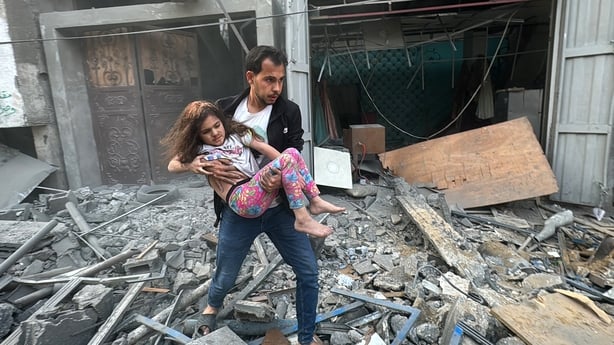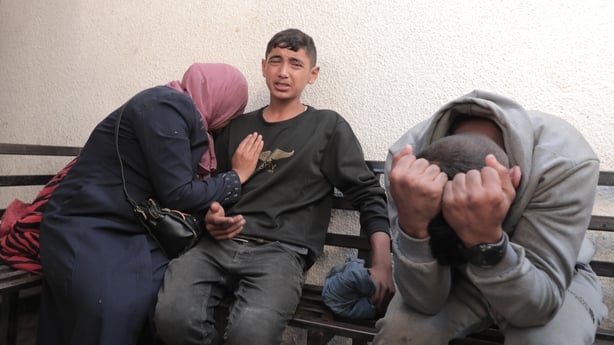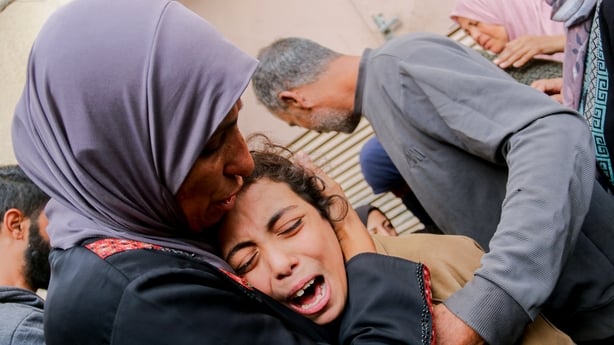There is a "strong likelihood that famine is imminent in areas" of northern Gaza, a committee of global food security experts has warned, as Israel pursues a military offensive against Palestinian militant group Hamas.
"Immediate action, within days not weeks, is required from all actors who are directly taking part in the conflict, or have influence on its conduct, to avert and alleviate this catastrophic situation," the independent Famine Review Committee (FRC) said in a rare alert.
The warning comes just days ahead of a deadline from the United States for Israel to improve the humanitarian situation in Gaza or face potential restrictions on US military aid.
Israel's mission to the United Nations in New York did not immediately respond to a request for comment.
"If no effective action is taken by stakeholders with influence, the scale of this looming catastrophe is likely to dwarf anything we have seen so far in the Gaza Strip since 7 October 2023," the FRC committee said.
The UN Office for the Coordination of Humanitarian Affairs estimates that between 75,000 and 95,000 people are still in northern Gaza.
The FRC said that it could be "assumed that starvation, malnutrition, and excess mortality due to malnutrition and disease, are rapidly increasing" in northern Gaza.
"Famine thresholds may have already been crossed or else will be in the near future," it said.
The US said that it is watching the Israeli offensive in northern Gaza to ensure that its ally's actions show that it does not have a "policy of starvation" in the area.
The FRC reviews findings by the global hunger monitor - an internationally recognised standard known as the Integrated Food Security Phase Classification (IPC).

The IPC defines famine as when at least 20% of people in an area are suffering extreme food shortages, with at least 30% of children acutely malnourished and two people out of every 10,000 dying daily from starvation or malnutrition and disease.
The IPC is an initiative involving UN agencies, national governments and aid groups that sets the global standard on measuring food crises.
The IPC warned last month that the whole of Gaza was at risk of famine, while UN officials last week described northern Gaza as "apocalyptic" and said that everyone there was "at imminent risk of dying from disease, famine and violence".
The amount of aid entering Gaza has plummeted to its lowest level in a year, according to UN data, and the organisation has repeatedly accused Israel of hindering and blocking attempts to deliver aid, particularly to the north of the territory.

Israel's Ambassador to the UN Danny Danon told the Security Council last month that the issue in Gaza was not a lack of aid, saying that more than one million tonnes had been delivered during the past year.
He accused Hamas of hijacking the assistance.
Hamas has repeatedly denied Israeli allegations that it was stealing aid and said that Israel is to blame for shortages.
"The daily average number of trucks entering Gaza in late October was about 58 per day," Jean-Martin Bauer, of the UN World Food Programme said.
"We were getting about 200 a day in September and August, so that's really a big, big decline," he added.
Nearly 70% of Gaza war dead women and children - UN
The UN Human Rights Office said that nearly 70% of the fatalities it has verified in the Gaza war were women and children, and condemned what it called a systematic violation of the fundamental principles of international humanitarian law.
The figure covers the first seven months of the conflict.
However, it only includes fatalities that the office has managed to verify with three sources, and counting continues.
The 8,119 victims verified in the seven-month period is considerably lower than the toll of over 43,000 provided by Palestinian health authorities for the full 13 months of conflict.
But the UN breakdown of the victims' age and gender backs the Palestinian assertion that women and children represent a large portion of those who have died.
This finding indicates "a systematic violation of the fundamental principles of international humanitarian law, including distinction and proportionality," the UN rights office said in a statement accompanying the 32-page report.
"It is essential that there is due reckoning with respect to the allegations of serious violations of international law through credible and impartial judicial bodies and that, in the meantime, all relevant information and evidence are collected and preserved," UN High Commissioner for Human Rights Volker Turk said.

Head of the UN Human Rights Office for the Occupied Palestinian Territory Ajith Sunghay told reporters in Geneva that the fatalities included in the report were verified by three sources such as neighbours, family members, local non-governmental organisations, hospital records or UN staff.
"The numbers are, of course, massive compared to previous years, so we do need time to catch up and verify", he said.
Mr Sunghay added that he thought the final UN tally is likely to be similar to the Palestinian toll.
Israel did not immediately comment on the report's findings.
The Israeli military said that it takes care to avoid harming civilians in Gaza.
It added that approximately one civilian has been killed for every fighter - a ratio it blames on Hamas - saying the Palestinian militant group uses civilian facilities.
Hamas has denied using civilians and civilian infrastructure, including hospitals, as human shields.
The youngest victim whose death was verified by UN monitors was a one-day-old boy, and the oldest was a 97-year-old woman, the report said.
Overall, children accounted for 44% of the victims, with those aged between five and nine representing the single biggest age category, followed by those aged 10-14, and then those aged up to and including four.
This broadly reflects Gaza's demographics, which the report said reflected an apparent failure to take precautions to avoid civilian losses.
It showed that, in 88% of cases, five or more people were killed in the same attack, pointing to the Israeli military's use of weapons with an effect across a wide area, although it said that some fatalities may have been the result of errant projectiles from Palestinian armed groups.

